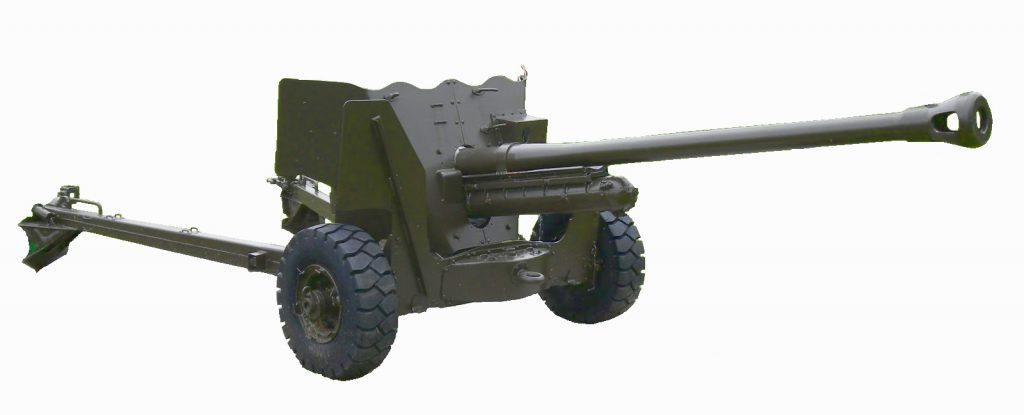
Once the 2 pounder Anti-Tank Gun had been issued, work started on its replacement. A 6 pounder 57mm calibre weapon was chosen because the calibre had been in use since the 1880’s therefore barrel making machinery & ammunition production were available along with a knowledge of the ballistics. The design was ready in 1938 & a test gun made & fired in 1939. The design was then sealed & put aside until it was needed.
The gun should have been put in to production in 1940 but the heavy losses of 2 pounder guns needed immediate replacement. To put the gun into production & train the crews would have taken considerable time so it was decided to continue production of the 2 pounder for the time being. The first 6 pounders were not made until November 1941. By May 1942, 1,500 guns a month were being produced.
The guns replaced the 2 pounders in anti-tank regiments & later were issued to infantry battalions as stocks allowed. Some were given to the Soviet & American armies. The latter copied it as the 57mm Gun. The gun originally had a traverse handwheel but this was changed on production models to free traverse controlled by the layer having a shoulder pad under his arm & pushing the gun from side to side. This system had been used for many years in coast & light naval guns.
The 6 pounder was also the principal British tank gun for a lot of the war. An auto-loader was produced for a proposed 1 man tank destroyer, superseded by the issue of the 17 pounder but the Royal Navy took the project over as armament for fast coastal craft. It was very successful.
The RAF also showed an interest, mounting the 6 pounder in a Mosquito as an anti-submarine weapon. 12 guns were fitted operating over the Atlantic with some success. They were replaced by rocket systems.
Gun
| Mark 1 | Original development model. A few made in 1939, none issued to service |
| Mark 2 | Production model for towed carriage |
| Mark 3 | For tanks. As Mk 2 but with lugs on the breech ring for tank mounting |
| Mark 4 | As Mk 2 but barrel 16 inches longer with a muzzle brake to improve muzzle velocity |
| Mark 5 | As Mk 3 but 16 inches longer with muzzle counterweight |
| ‘C’ Marks 3, 4, 5 | As Mk’s 3, 4, 5 but Canadian manufacture |
Carriage
| Mark 1 | Original split trail production model |
| Mark 1A | As Mk 1 but different axle-tree & wheels |
| C Mark 1 | Mk 1 Canadian manufactured |
| Mark 2 | Slightly simplified design as a production alternative to Mk 1. Not adopted |
| Mark 3 | Lightened Mk 1 for airborne use |
Data
Gun Mk 2 on Carriage Mk 1
| Weight of gun & breech mechanism | 768 lbs |
| Total Length | 100.95 inches |
| Length of Bore | 96.2 inches (43 calibres) |
| Rifling | 24 grooves, uniform Right Hand 1/30 |
| Breech Mechanism | Vertical sliding block, semi-automatic, percussion fired |
| Elevation | -5° to +15° |
| Traverse | 45° Left & Right |
| Recoil System | Hydro-spring, constant, 30 inches |
| Weight in action | 2,521 lbs |
| Mk 4 Gun as above except | |
| Length of Gun | 116.95 inches |
| Length of Bore | 112.2 inches (50 calibres) |
Performance
Firing standard 6 lb AP Shot
| Muzzle Velocity | 2,693 feet/second |
| Maximum Range | 5,500 yards |
| Penetration | 74 mm at 1,000 yards, 30° angle |
Firing Shot, APDS Mk 1T
| Weight | 3.25 lbs |
| Muzzle Velocity | 4,050 feet/second |
| Penetration | 146 mm plate at 1,000 yards |
Ammunition
| Shot, Armour Piercing Marks 1 to 7T | Plain steel solid shot |
| Shot, Armour Piercing Cap Mark 8T | Similar to AP shot plus penetrative cap to attack face hardened plate |
| Shot, Armour Piercing Cap Ballistic Cap Mark 9T | As for APC but with a light ballistic cap. Improved penetration |
| Shot, Armour Piercing Composite Rigid Mark 1T | Provided in small quantities October 1943. A tungsten core built up to full calibre by a light alloy body. Performance good at short range but dropped of rapidly as range increased. |
| Shot, Armour Piercing Discarding Sabot Mark 1T | Issued June 1944. Tungsten core in light steel sheath. Built up to full calibre by 4 piece light alloy sabot discarded at the muzzle on firing |
| Shell, High Explosive Mark 10T | Nose fuzed HE shell fitted with percussion fuze No. 243 |
